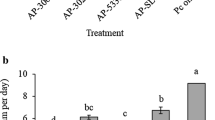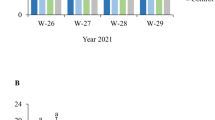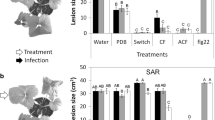Abstract
Efficacy and mode of action were investigated fox Aureobasidium pullulans, a potential biocontrol agent for grey mould on strawberry fruit. Wound inoculation of detached green strawberry cv. Elsanta fruit with Aureobasidium pullulans prevented grey mould rot on fruit inoculated 2 days later with Botrytis cinerea. Treatment of white, pink and red-ripe fruit did not, however, control grey mould. Treatment of wound sites on green fruit with both live and heat-killed A. pullulans cells reduced B. cinerea infection compared to controls. Dip-inoculation of unwounded green strawberry fruit with A pullulans when still attached to the plant delayed the development of grey mould after harvest at the fully ripe stage. The (i) efficacy of A. pullulans on green but not on ripening fruit, (ii) partial inhibitory effect of both live and heat-killed A. pullulans cells and (iii) absence of evidence for antibiotic production from in vitro competition tests suggest that control of grey mould on green fruit is at least partly due to a mechanism other than antagonism and / or competition. Bioassays showed that skin tissue from green fruit treated with A. pullulans had greater antifungal activity than control tissue. Thus, enhanced natural disease resistance in green strawberry fruit contributed to grey mould rot suppression by A. pullulans.
Similar content being viewed by others
References
Andrews JH, Harris RF, Spear RN, Laun GW, Nordheim EV (1994) Morphogenesis and adhesion of Aureobasidium pullulans. Canadian Journal of Microbiology 40, 6–17.
Bhatt DD, Vaughan EK (1962) Preliminary investigations on biological control of grey mould (Botrytis cinerea) in strawberries. Plant Disease Reporter 46, 342–345.
Blakeman JP, Brodie, IDS (1977) Competition for nutrients between epiphytic microorganisms and germination of spores of fungal pathogens on beetroot leaves. Physiological Plant Pathology 10, 29–42.
Blakeman JP, Fokkema NJ (1982) Potential for biological control of plant diseases on the phylloplane. Annual Reviews of Phytopathology 20, 167–192.
Bristow PP, McNicol RJ, Williamson B (1986) Infection of strawberry flowers by Botrytis cinerea and its relevance to grey mould development. Annals of Applied Biology 72, 545–554.
Buhagiar RWM, Barnett JA (1971) The yeasts of strawberries. Journal of Applied Bacteriology 34, 727–739.
Castoria R, De Curtis F, Lima G, Caputo L, Pacifico S, De Cicco V (2001) Aureobasidium pullulans (LS-30) an antagonist of postharvest pathogens of fruits: study on its modes of action. Postharvest Biology and Technology 22, 7–17.
Droby S, Chalutz E (1994) Mode of action of biocontrol agents for postharvest diseases. In ‘Biological Control of Postharvest Diseases of Fruits and Vegetables—Theory and Practice’. (Eds CL Wilson and ME Wisniewski) pp. 63–75. (CRC Press: Florida)
El Ghaouth A, Wilson C, Wisniewski M (1998) Ultrastructural and cytochemical aspects of the biocontrol activity of Candida saitoana in apple fruit. Phytopathology 88, 282–291.
Filippone MP, Diaz Ricci J, De Marchese AM, Farias RN, Castagnaro A (1999) Isolation and purification of a 316 Da preformed compound from strawberry (Fragaria ananassa) leaves active against plant pathogens. FEBS Letters 459, 115–118.
Fokkema NJ (1973) Therole of saprophytic fungi in antagonism against Drecshlera sorokiniana (Helminthosporium sativum) on agar plates and on rye leaves with pollen. Physiological Plant Pathology 3, 195–205.
Fokkema NJ, Lorbeer JW (1974) Interactions between Alternariaporri and the saprophytic micro flora of onion leaves. Phytopathology 64, 1128–1133.
Howard CM (1990) The pesticide squeeze on strawberries. In ‘The Strawberry into the 21 st Century, Proceedings of the 3rd North American strawberry conference’. (Eds A Dale and JJ Luby) pp. 181–182. (Timber Press: Oregon, USA)
Ippolito A, El Ghaouth A, Wilson CL, Wisniewski M (2000) Control of postharvest decay of apple fruit by Aureobasidium pullulans and induction of defence responses. Postharvest Biology and Technology 19, 265–272.
Ippolito A, Nigro F (2000) Impact of preharvest application of biological control agents on postharvest diseases of fresh fruits and vegetables. Crop Protection 19, 715–723.
Ippolito A, Nigro F, Romanazzi G, Campanella A (1997) Field application of Aureobasidium pullulans against Botrytis storage rot of strawberry. In ‘Non-conventional methods for the control of postharvest diseases and microbiological spoilage, Workshop Proceedings COST 914-COST 915’ Bologna, Italy. (Eds P Bertoloni, PC Sijmons, ME Guerzoni, F Serra) pp. 127–133.
Jarvis WR (1962) The infection of strawberry and raspberry fruits by Botrytis cinerea. Annals of Applied Biology 50, 569–575.
Jarvis WR (1980) Epidemiology. In ‘The Biology of Botrytis’. (Eds JR Coley-Smith, WR Jarvis) pp. 219–250. (Academie Press: London)
Jersch S, Scherer C, Huth G, Schlösser E (1989) Proanthocyanidins as basis for quiescence of Botrytis cinerea in immature strawberry fruits. Journal of Plant Diseases and Protection 96, 365–378.
Klarman WL, Stanford JB (1968) Isolation and purification of an antifungal principle from infected soybeans. Life Sciences 7, 1095–1103.
Köhl JR, Belanger R, Fokkema NJ (1997) Interactions of four antagonistic fungi with Botrytis aclata in dead onion leaves: a comparative microscopie and ultrastructural study. Phytopathology 87, 634–642.
Lima G, Ippolito A, Nigro F, Salerno M (1997) Effectiveness of Aureobasidium pullulans and Candida oleophila against postharvest strawberry rots. Postharvest Biology and Technology 10, 169–178.
McCormack PJ, Wildman HG, Jeffries P (1994) Production of antibacterial compounds by phylloplane-inhabiting yeasts and yeast-like fungi. Applied EnvironmentalMicrobiology 60, 927–931.
Mussell HW, Staples RC (1971) Phytoalexin-like compounds apparently involved in strawberry resistance to Phytophthora fragariae. Phytopathology 61, 515–517.
Peng G, Sutton JC (1991) Evaluation of microorganisms for biocontrol of Botrytis cinerea in strawberry. Canadian Journal of Plant Pathology 13, 247–257.
Powelson RL (1960) Initiation of strawberry fruit rot caused by B. cinerea. Phytopathology 50, 491–494.
Pratella GC, Mari M (1993) Effectiveness of Trichoderma, Gliocladium and Paecilomyces in postharvest fruit protection. Postharvest Biology and Technology 3, 49–56.
Rodov V, Ben-Yehoshua S, Albaglis R, Fang D (1994) Accumulation of phytoalexins scoparone and scopoletin in citrus fruits subjected to various postharvest treatments. Acta Horticulturae 38, 517–523.
Schena L, Ippolito A, Zahavi T, Cohen L, Nigro F, Droby S (1999) Genetic diversity and biocontrol activity of Aureobasidium pullulans isolates against postharvest rots. Postharvest Biology and Technology 17, 189–199.
Swadling IR and Jeffries P (1996) Isolation of micro bial antagonists for biocontrol of grey mould disease of strawberries. Biocontrol Science and Technology 6, 125–136.
Tronsmo A (1986) Trichoderma used as a biocontrol against Botrytis cinerea rots of strawberry and apple. Meldinger Fra Norges Landbrukshogskole 165, 1–22.
Tronsmo A, Dennis C (1997) The use of Trichoderma species to control strawberry fruit rots. Netherlands Journal of Plant Pathology 83 (suppl. I), 449–155.
Washington WS, Shanmuganathan N, Forbes C (1992) Fungicidal control of strawberry fruit rots, and field occurrence of resistance of Botrytis cinerea to iprodione, benomyl and dichlofluanid. Crop Protection 11, 355–360.
Wilson CL, Wisniewski ME (1994) ‘Biological control of postharvest diseases of fruits and vegetables — Theory and Practice’. (CRC Press: Florida)
Author information
Authors and Affiliations
Corresponding author
Rights and permissions
About this article
Cite this article
Adikaram, N.K.B., Joyce, D.C. & Terryc, L.A. Biocontrol activity and induced resistance as a possible mode of action for Aureobasidium pullulans against grey mould of strawberry fruit. Australasian Plant Pathology 31, 223–229 (2002). https://doi.org/10.1071/AP02017
Received:
Accepted:
Issue Date:
DOI: https://doi.org/10.1071/AP02017




